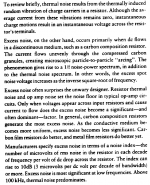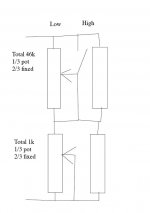Most people, myself included, don't have what it takes to measure resistors to such degree. Just knowing that some resistors have high excess noise is just more frustrating, instead of helpful. What'd be helpful is to get some data from people like you who do have access to such measurements. At least pointers to where data can be found.
Can't really find it as excess noise; could it be called "current noise" in some data sheets? For instance Vishay Z-bulk metal foil series RNC90Z mentions less than 42 dB current noise.
Doug Grant and Scott Wurcer mention excess noise in AN-348.
Doug Grant and Scott Wurcer mention excess noise in AN-348.
Attachments
douglas Self has measured Resistor noise and distortion in his new book.
He tested Through Hole and SMD.
Here is his list of excess noise:
Noise (uv/V)
Carbon - film TH 0.2 - 3
Metal - oxyde TH 0.1 - 1
Thin - film SM 0.05 - 0.4
Bulk metal - foil TH 0.01
Wirewound TH 0
He found that distortion is higher in small resistor packages and thin film SMD is much better then thick film SMD. So the best resistor whould be a big value wirewound TH folloded by a big value Bulk metal. With "big" i meen resonable size.
For example a 0402 thin-film SMD had 40dB more distortion at 10kHz then a 1206 case.
A 0402 thick - film had even 45dB more distortion at 10kHz.
btw, i have another idea for cartridge loading with potmeters.
i will do i little scetch.
He tested Through Hole and SMD.
Here is his list of excess noise:
Noise (uv/V)
Carbon - film TH 0.2 - 3
Metal - oxyde TH 0.1 - 1
Thin - film SM 0.05 - 0.4
Bulk metal - foil TH 0.01
Wirewound TH 0
He found that distortion is higher in small resistor packages and thin film SMD is much better then thick film SMD. So the best resistor whould be a big value wirewound TH folloded by a big value Bulk metal. With "big" i meen resonable size.
For example a 0402 thin-film SMD had 40dB more distortion at 10kHz then a 1206 case.
A 0402 thick - film had even 45dB more distortion at 10kHz.
btw, i have another idea for cartridge loading with potmeters.
i will do i little scetch.
Actually, voltage coefficient is DIFFERENT from excess noise. Excess noise, often called the NOISE INDEX, is a little difficult to interpret without formulas, but generally speaking metal film resistors are about 10 times quieter than carbon film resistors, and sometimes almost as good as wirewound resistors, for many applications, especially without too much DC voltage involved. Unless you are a noise nut, like Joachim or me, usually any quality metal film resistor will be adequate. I recommend: "Low Noise Electronic design' pp. 176-179 Read it if you have it.
Last edited:
SY, please don't waste our time with a useless input.
If you've got data showing excess noise in wirewounds, let's see it. That will be news to many.
The extra cost of wirewounds would keep most here from using them. You should know better.
In reality, there are only a few critical resistors. What's $20-25 in a high end design? You spend more than that on a single cap. If the thread is now about bargain basement construction, then I apologize for butting in.
Can't really find it as excess noise; could it be called "current noise" in some data sheets? For instance Vishay Z-bulk metal foil series RNC90Z mentions less than 42 dB current noise.
Doug Grant and Scott Wurcer mention excess noise in AN-348.
"Particle to particle arcing" did I say that, you caught me?
"Particle to particle arcing" did I say that, you caught me?
You could always blame your co-author
For on the cheap wirewound resistors I got some time ago some 46ga evanohm at 375 ohms/foot, to roll my own. There are even more exotic materials with more resistance per foot and very good tempco that could be used. It's not for everyone though, and the winding has to be non-inductive. One other advantage is that one can use short silver leads. With wood core, throw some shellac over it and Bob's your uncle. But yes, they'll be fugly.
Here is some decent information.
Thoose guys are 1 hour from my house and must have made swords in the midle ages.
http://www.isabellenhuette.de/uploads/media/TECHN-INFO-IH.pdf
Thoose guys are 1 hour from my house and must have made swords in the midle ages.
http://www.isabellenhuette.de/uploads/media/TECHN-INFO-IH.pdf
That´s the way to wind a noninductive wirewound ; Ayrton-Perry winding - Wikipedia, the free encyclopedia
ISA-Chrom80 is quite stable
ISA-Chrom80 is quite stable
One other advantage is that one can use short silver leads. With wood core, throw some shellac over it and Bob's your uncle. But yes, they'll be fugly.
Not necessarily. Done right they could be absolutely beautiful.
se
Actually, voltage coefficient is DIFFERENT from excess noise. Excess noise, often called the NOISE INDEX, is a little difficult to interpret without formulas, but generally speaking metal film resistors are about 10 times quieter than carbon film resistors, and sometimes almost as good as wirewound resistors, for many applications, especially without too much DC voltage involved. Unless you are a noise nut, like Joachim or me, usually any quality metal film resistor will be adequate. I recommend: "Low Noise Electronic design' pp. 176-179 Read it if you have it.
John, I'm not one to shy away from doing the leg work necessary to find info whether in a book or data sheet. That's precisely why I asked, because I'm having a hard time finding any data sheet that mentions noise index or excess noise.
Joachim, good info, thanks!
- Status
- Not open for further replies.
- Home
- Member Areas
- The Lounge
- John Curl's Blowtorch preamplifier part II

